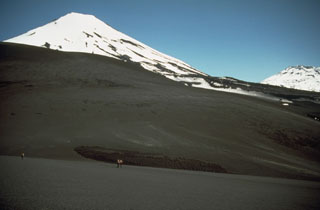Report on Lonquimay (Chile) — January 1990
Bulletin of the Global Volcanism Network, vol. 15, no. 1 (January 1990)
Managing Editor: Lindsay McClelland.
Lonquimay (Chile) Lava emission slows from base of Navidad Cone; slumping follows partial collapse of lava drainage channel
Please cite this report as:
Global Volcanism Program, 1990. Report on Lonquimay (Chile) (McClelland, L., ed.). Bulletin of the Global Volcanism Network, 15:1. Smithsonian Institution. https://doi.org/10.5479/si.GVP.BGVN199001-357100
Lonquimay
Chile
38.379°S, 71.586°W; summit elev. 2832 m
All times are local (unless otherwise noted)
During observations on 10 January from 1200 to 1530, lava emission continued from the vent at the NE foot of Navidad Cone. The black aa lava had a surface velocity of 70 m/hour as it moved through a pre-existing channel, which widened progressively from 7 to 12 m over a distance of 50 m from the source. The vent was triangle-shaped, 7 m wide and 4-5 m high, elongating within to a glowing tunnel that had not been exposed during 20 November fieldwork. Activity in the main crater was limited to fumarolic emission that varied gradually from white-yellowish to blue. A vapor cloud was distinctly visible 300-500 m above the cone.
Geologists climbed to the cone's summit on 20 January between 1145 and 1630. Blue fumarolic emissions were continuous from the central crater, nested within the eastern part of the formerly horseshoe-shaped main crater. Annular fractures surrounding the central crater had been emitting vapor on 20 November, but vapor emission had ceased by 20 January after a period of relatively dry weather. Collapse had occurred along some of the fractures, widening the funnel-shaped crater to 60-70 m. A hole 3-4 m in diameter, formerly the main steam jet vent, was clearly visible in the N inner wall, without gas emission.
Between 10 and 20 January, the rate of lava production had clearly decreased, and the 14-m-high wall of the drainage channel had partially collapsed. This process triggered discontinuous slumping of flank material directly above the vent, producing dense dust clouds. The slumped debris was transported on the lava surface, aligned in arched transverse ridges representing different slumping episodes. By the end of field observations at 1630 on 20 January, these materials had been carried as much as 500 m from the vent. An overflight the same day at about 1730 showed that advance had ceased along the entire flow front, including the lobe in the Lolco River valley, which remained 10.7 km from the vent as on 20 November.
Major and trace element analyses of lava and bombs sampled in July and November show no significant variation, being very similar to samples from early in the eruption (Moreno and Gardeweg, 1989).
Geological Summary. Lonquimay is a small, flat-topped, symmetrical stratovolcano of late-Pleistocene to dominantly Holocene age immediately SE of Tolguaca volcano. A glacier fills its summit crater and flows down the S flank. It is dominantly andesitic, but basalt and dacite are also found. The prominent NE-SW Cordón Fissural Oriental fissure zone cuts across the entire volcano. A series of NE-flank vents and scoria cones were built along an E-W fissure, some of which have been the source of voluminous lava flows, including those during 1887-90 and 1988-90, that extended out to 10 km.
Information Contacts: J. Naranjo, SERNAGEOMIN, Santiago; H. Moreno, Univ de Chile.

